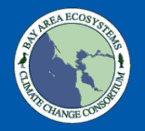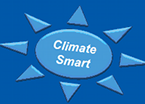Workshop: Climate-Smart Actions for Natural Resource Managers
 |
Guidance for incorporating climate change into conservation and restoration strategies was provided in two Climate-Smart Actions for Natural Resource Managers workshops hosted by BAECCC and sponsored by the Gordon and Betty Moore Foundation, the California Landscape Conservation Cooperative, California Coastal Conservancy, and The Nature Conservancy on November 29, 2012 and September 24, 2013. Materials from both of these workshops are presented here. |  |
Desired Outcome of the Workshops:
Natural resource managers, scientists, non-governmental organizations and regulators collaborate as an integrated community to identify climate change challenges to ecosystems and develop shared solutions.
Workshop Objectives:
1) Natural resource managers learn how to incorporate “climate smart” actions into their work to enhance the resilience of ecosystems.
2) Researchers gain a better understanding of the needs of natural resource managers in order to develop information important for mitigation and adaptation decisions.
| Climate-Smart Workshop, September 24, 2013 |
|---|
Agenda
Presentations:
Projected Climate Change Impacts to the San Francisco Bay Ecosystem and Region – Tom Suchanek, Climate Change Coordinator, Western Ecological Research Center, US Geological Survey
Regional and Local Climate Change Impact Projections: The Terrestrial Biodiversity Climate Change Consortium - David Ackerly, UC Berkeley
Principles for Climate Smart Conservation – Ellie Cohen, President and CEO, Point Blue Conservation Science
| See also the Principles for Climate Smart Conservation document |
Bridging Vulnerability Assessment to Conservation Action: Case Study of the Upper Pajaro River Floodplain Restoration - Kirk Klausmeyer, Conservation Planner, The Nature Conservancy
The STRAW Climate Smart Stream Restoration Case Study- John Parodi, STRAW Restoration Manager, Point Blue Conservation Science
Staying Abreast of Climate Change Data and Tools: California Climate Commons – Deanne DiPietro, Data Manager, California Landscape Conservation Cooperative
| Climate-Smart Workshop, November 29, 2012 |
|---|
Agenda
Presentations:
Introduction to the Workshop: Climate-Smart Actions for Natural Resource Managers
Andy Gunther, BAECCC Executive Coordinator, Executive Director at Center for Ecosystem Restoration and Management
Projected Climate Change Impacts to the San Francisco Bay Ecosystem and Region
Tom Suchanek, Climate Change Coordinator, Western Ecological Research Center, USGS
Principles for Climate-Smart Conservation
Ellie Cohen, President and CEO, Point Blue Conservation Science
| See also the Principles for Climate Smart Conservation document and this video of Ellie's Presentation |
Vulnerability Assessment Overview
Kirk Klausmeyer, The Nature Conservancy
Redwood Creek Restoration at Muir Beach Case Study – Carolyn Shoulders, Restoration Ecologist, Golden Gate National Recreation Area
Upper Pajaro River Floodplain Restoration Case Study – Sasha Gennet, Central Coast Ecologist, The Nature Conservancy
Sears Point Restoration Case Study - Julian Meisler, Baylands Program Manager, Sonoma Land Trust
The STRAW Climate Smart Stream Restoration Case Study - John Parodi, STRAW Restoration Manager, PRBO Conservation Science
Regional and local climate change impact projections: The Terrestrial Biodiversity Climate Change Consortium - David Ackerly, UC Berkeley
Staying Abreast of Climate Change Data and Tools: California Climate Commons – Deanne DiPietro, Data Manager, California Landscape Conservation Cooperative
| Case Studies -- Examples of Climate-Smart Strategies and Actions |
|---|
Redwood Creek Restoration at Muir Beach, National Park Service
This 46-acre landscape-level restoration at Muir Beach will restore fluvial and coastal processes at the mouth of the watershed, and will enhance ecosystem adaptation to changing groundwater elevations, storm surges, tidal influences, and more intense flood events.
| Case Study Write-up | Presentation by Carolyn Shoulders |
Upper Pajaro River Floodplain Restoration, The Nature Conservancy
This project will restore riparian habitat along the upper Pajaro River in a manner that will address identified vulnerabilities to climate change, including maintaining migratory corridors for wildlife and the storing flood waters to protect downstream communities during storms. The summary includes valuable lessons learned during the conduct of the vulnerability analysis.
| Case Study Write-Up | Presentation by Sasha Gennet | Bobcat Kitten Video |
Sears Point Restoration, Sonoma Land Trust
This project will restore/enhance 960 acres of tidal marsh and nearly 1,350 acres of associated ecotonal seasonal wetlands, riparian corridors, and upland grasslands at Sears Point. Specific design elements have been included to hasten marsh development and provide resilience against sea level rise.
| Case Study Write-Up | Presentation by Julian Meisler |
STRAW Climate-Smart Stream Restoration, PRBO Conservation Science
This project is incorporating climate smart streamside restoration designs that can accommodate expected changes in temperature and precipitation (usually warmer and drier), changes in extreme events (i.e., more frequent drought and more intense precipitation events), and disrupted wildlife and plant phenology.
| Case Study Write-Up | Presentation by John Parodi |
Breuner Marsh Restoration, East Bay Regional Park District
This project will restore/enhance 60 acres of wetlands and 90 acres of coastal prairie designed to evolve naturally with climate change. The project is designed to accommodate a projected 55-inch rise in sea level by the year 2100, reusing fill already on site to establish upland transition zones where tidal wetlands can migrate as sea level rises.
| Case Study Write-Up |
Farallon Seabird Nest Site Enhancement, Point Blue Conservation Science
This project is modifying artificial nesting boxes installed on Southeast Farallon Island in the early 1970's to provide seabirds such as Cassin's Auklets and Rhinoceros Auklets additional nesting habitat. Nesting boxes are being modified to keep these artificial habitats at temperatures closer to natural burrows despite higher temperatures expected due to climate change.
| Case Study Write-Up |
Shoreline Change San Pablo Bay Pilot Study: Understanding Spatial Patterns of Marsh Sensitivity and Resilience, San Francisco Estuary Institute
This project is an analysis of long- and short-term rates of tidal marsh erosion in San Pablo Bay, and is developing initial understandings of the physical processes driving these trajectories and the implications for management strategies to protect and restore the marsh shoreline.
| Case Study Write-Up |
8/2017
